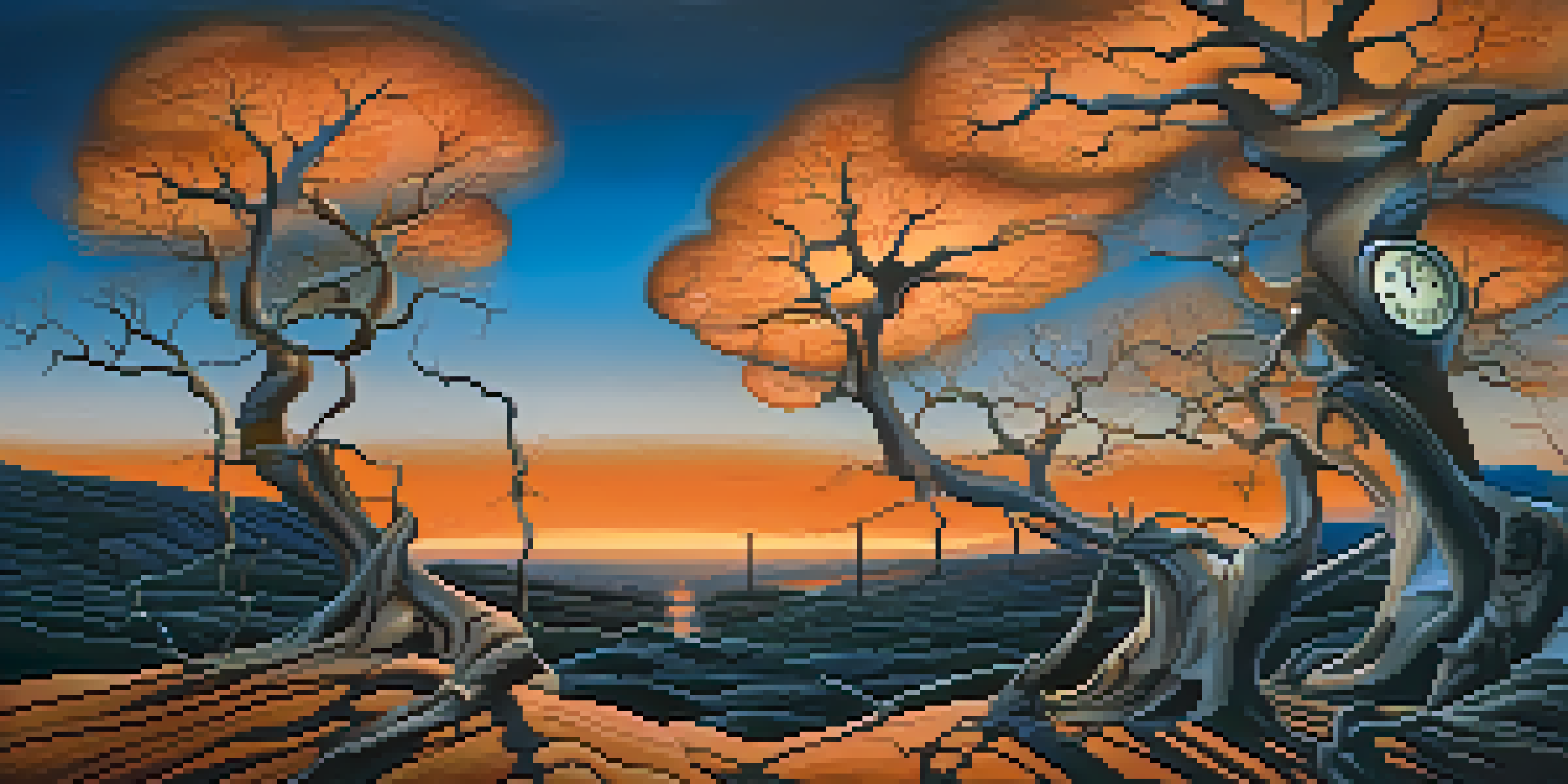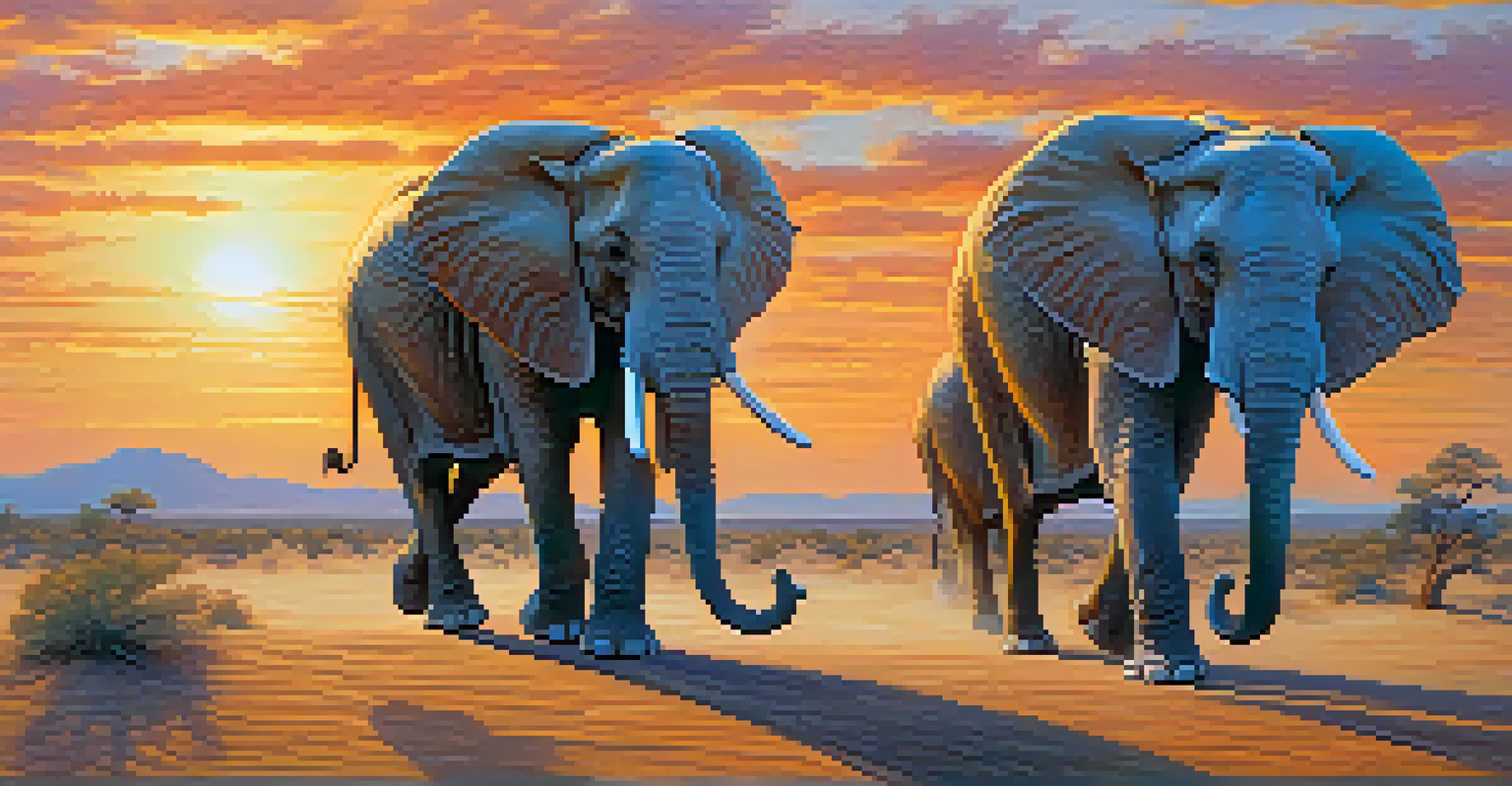Dali and Drugs: The Intersection of Hallucinogens and Art

Salvador Dali: A Brief Overview of His Artistic Genius
Salvador Dali, one of the most iconic surrealists, is known for his dreamlike imagery and eccentric personality. His works often challenge the boundaries of reality, drawing viewers into a world where the bizarre feels familiar. Dali's artistic journey was not just about technique; it was deeply intertwined with his exploration of the subconscious mind.
The only difference between a madman and me is that I am not mad.
Born in Catalonia, Spain, in 1904, Dali developed a passion for art at a young age, eventually studying at the Royal Academy of Fine Arts. His unique style and flamboyant persona quickly made him a standout figure in the surrealist movement. Through his paintings, sculptures, and films, Dali sought to provoke thought and evoke emotion, often leaving audiences questioning the nature of reality.
Dali's use of symbolism and meticulous attention to detail are hallmarks of his work. However, it’s essential to consider how external factors, like his fascination with hallucinogens, shaped his artistic vision and allowed him to push the boundaries of creativity.
The Surrealist Movement and Its Embrace of the Unconscious
The surrealist movement emerged in the early 20th century as a response to the rationalism of the Enlightenment. Surrealists aimed to explore the depths of the unconscious mind, often utilizing dreams and subconscious thoughts to inspire their art. This desire to tap into hidden realities resonated deeply with Dali and his contemporaries.

Dali, in particular, believed that the unconscious held the keys to creativity. He often employed techniques like 'paranoiac-critical method,' where he would induce a state of heightened perception to access deeper thoughts and emotions. This quest for understanding the subconscious was pivotal in shaping the surrealist aesthetic.
Dali's Surrealist Techniques
Salvador Dali's unique approach, blending symbolism and the exploration of the subconscious, defines his surrealist masterpieces.
In this context, hallucinogens emerged as a fascinating tool for some artists. Substances like LSD and psilocybin mushrooms were thought to unlock new realms of creativity, enabling artists to perceive the world in ways that might not be possible through sober thought alone.
The Role of Hallucinogens in Dali's Creative Process
Dali's experimentation with hallucinogens is often cited as a significant influence on his art. While he was known for his eccentric behavior and flamboyant lifestyle, he also sought to expand his mind through various substances. This exploration helped him challenge conventional perceptions and discover new artistic techniques.
The chief enemy of creativity is good sense.
For Dali, hallucinogens were more than just recreational; they were a gateway to a different kind of consciousness. He believed that by altering his state of mind, he could tap into a source of creativity that was otherwise unreachable. This perspective aligns with the broader surrealist ethos of breaking free from societal norms and expectations.
The vivid, dreamlike quality of Dali's paintings often mirrors the experiences of those who have explored altered states of consciousness. From melting clocks in 'The Persistence of Memory' to dreamlike landscapes in 'The Elephants,' his works invite viewers to experience a reality beyond the ordinary.
Iconic Works Influenced by Hallucinogenic Experiences
Several of Dali's most famous works can be interpreted through the lens of hallucinogenic influence. For instance, 'The Persistence of Memory' features distorted clocks that challenge the perception of time, a theme that resonates with the fluidity often experienced under the influence of certain substances. This painting exemplifies how altered states can lead to profound artistic expressions.
Another striking example is 'The Elephants,' where elongated, spindly-legged elephants traverse a dreamlike landscape. This surreal imagery evokes a sense of weightlessness and distortion, reminiscent of the visual experiences reported by those under hallucinogenic effects. Such representations blur the lines between reality and fantasy, capturing the essence of Dali's artistic philosophy.
Hallucinogens and Creativity
Dali's experimentation with hallucinogens played a crucial role in shaping his artistic vision and challenging conventional perceptions.
Dali's ability to translate these complex experiences into visual art is part of what makes his work so compelling. Each piece serves as a window into the mind of an artist who navigated the intricate relationship between altered states of consciousness and creativity.
Cultural Context: The 1960s and the Psychedelic Movement
The 1960s marked a cultural shift that embraced experimentation with hallucinogens, particularly within artistic communities. Influenced by figures like Dali, many artists began exploring the effects of psychedelics on their work, leading to a surge in vibrant colors, abstract forms, and surreal imagery. This period saw an explosion of creativity fueled by a desire to transcend conventional artistic boundaries.
During this time, the psychedelic movement emerged, celebrating the exploration of consciousness through art, music, and literature. Artists sought to express their experiences with hallucinogens, often creating works that reflected the shifting perceptions and realities they encountered. Dali’s legacy was felt strongly as his approach to the subconscious resonated with this new wave of creativity.
The intersection of Dali’s surrealism and the psychedelic movement highlights the enduring impact of hallucinogens on art. This cultural context serves as a reminder of how artists throughout history have sought to explore the depths of human experience, often using substances as a catalyst for their creativity.
The Debate: Artistic Authenticity vs. Substance Influence
The relationship between hallucinogens and artistic expression raises important questions about authenticity. Some argue that relying on substances to inspire creativity dilutes the artist's genuine vision and skill. Critics often contend that true artistry should stem from a clear mind, free from external influences.
On the other hand, proponents of the hallucinogen-art connection argue that these substances can enhance creative processes, offering new perspectives and insights. For many artists, including Dali, exploring altered states is part of a broader quest for understanding and self-expression. This debate underscores the complexity of human creativity and the various paths artists may take.
Cultural Impact of Dali's Work
Dali's legacy continues to influence modern art and culture, inspiring artists to explore the depths of imagination and the nature of reality.
Ultimately, the conversation around authenticity in art is multifaceted and subjective. Dali's work serves as a testament to the idea that creativity often flourishes at the intersection of personal experiences, whether they involve hallucinogens or other aspects of life.
Legacy: Dali's Enduring Influence on Art and Culture
Salvador Dali's legacy continues to resonate within the art world and beyond. His unique approach to creativity, which often included exploration of the subconscious and hallucinogenic experiences, has inspired countless artists across generations. Dali's ability to meld the bizarre with the beautiful has left an indelible mark on contemporary art.
Today, the influence of Dali's work can be seen in various forms of media, from visual art to film and music. The surreal and psychedelic aesthetics that characterize his paintings have become staples in popular culture, inviting new audiences to engage with the themes of dreams, perception, and reality.

As we reflect on Dali's contributions, it becomes clear that his exploration of hallucinogens was more than just a personal journey; it was part of a broader cultural movement that sought to challenge norms and redefine artistic expression. His work continues to encourage artists to push boundaries and explore the depths of their imagination.